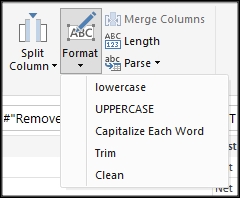For our customer health report, we need to create a single dataset that combines the sale pipeline information with the customer aging information.
Here is how we join the datasets:
Create a copy of the Accounts dataset and rename Customer Health.
In the Query View window, update the data type to text for both columns: AccountNumber and Customer_ID in the Customer Aging and Customer Health datasets.
Staying in the Query View window, select Format | Trim from the Transform tab under the main menu to ensure that there are no extra spaces in the AccountNumber and Customer_ID columns:

Select the Merge Columns tab under the Transform menu tab at the top of the Query View window. Merge the dataset with AccountNumber and Customer_ID:

After the merging process is complete, we will see the Dynamics GP Customer Aging information alongside the Account Sales information from Dynamics CRM:




